语法_过去分词作状语
- 格式:ppt
- 大小:1.02 MB
- 文档页数:33
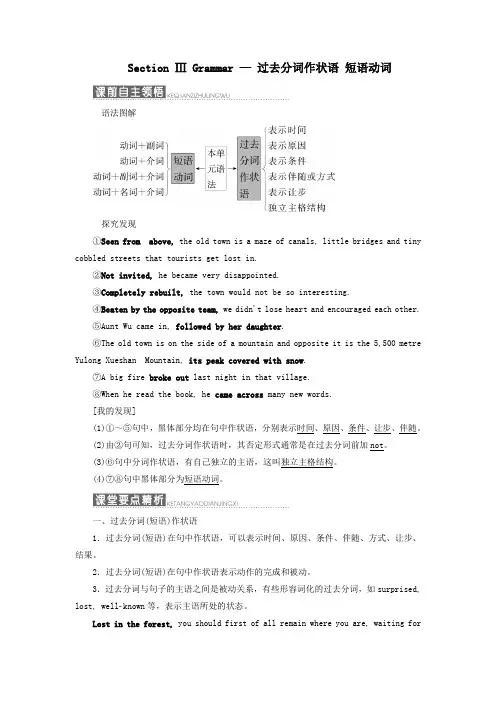
Section Ⅲ Grammar —过去分词作状语短语动词语法图解探究发现①Seen from above, the old town is a maze of canals, little bridges and tiny cobbled streets that tourists get lost in.②Not invited, he became very disappointed.③Completely rebuilt, the town would not be so interesting.④Beaten by the opposite team, we didn't lose heart and encouraged each other.⑤Aunt Wu came in, followed by her daughter.⑥The old town is on the side of a mountain and opposite it is the 5,500 metre Yulong Xueshan Mountain, its peak covered with snow.⑦A big fire broke out last night in that village.⑧When he read the book, he came across many new words.[我的发现](1)①~⑤句中,黑体部分均在句中作状语,分别表示时间、原因、条件、让步、伴随。
(2)由②句可知,过去分词作状语时,其否定形式通常是在过去分词前加not。
(3)⑥句中分词作状语,有自己独立的主语,这叫独立主格结构。
(4)⑦⑧句中黑体部分为短语动词。
一、过去分词(短语)作状语1.过去分词(短语)在句中作状语,可以表示时间、原因、条件、伴随、方式、让步、结果。
2.过去分词(短语)在句中作状语表示动作的完成和被动。
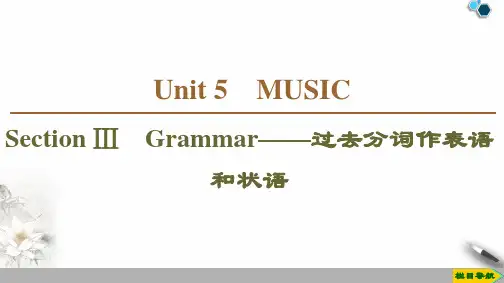
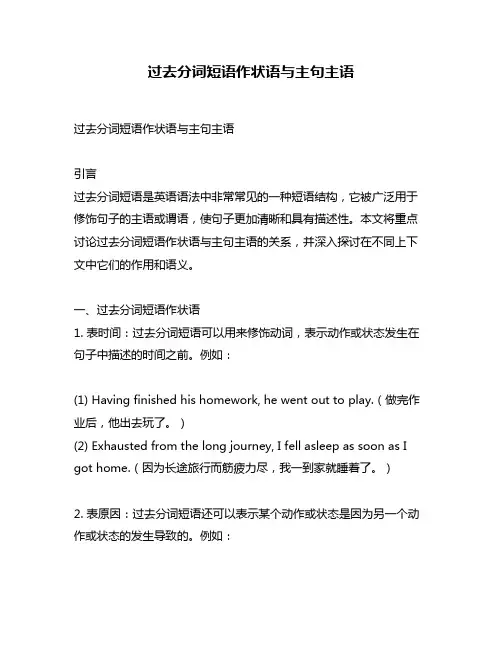
过去分词短语作状语与主句主语过去分词短语作状语与主句主语引言过去分词短语是英语语法中非常常见的一种短语结构,它被广泛用于修饰句子的主语或谓语,使句子更加清晰和具有描述性。
本文将重点讨论过去分词短语作状语与主句主语的关系,并深入探讨在不同上下文中它们的作用和语义。
一、过去分词短语作状语1. 表时间:过去分词短语可以用来修饰动词,表示动作或状态发生在句子中描述的时间之前。
例如:(1) Having finished his homework, he went out to play.(做完作业后,他出去玩了。
)(2) Exhausted from the long journey, I fell asleep as soon as I got home.(因为长途旅行而筋疲力尽,我一到家就睡着了。
)2. 表原因:过去分词短语还可以表示某个动作或状态是因为另一个动作或状态的发生导致的。
例如:(1) She missed the bus, being late for work.(她错过了公交车,因为迟到上班。
)(2) The team lost the match, having made too many mistakes.(由于犯了太多错误,队伍输掉了比赛。
)3. 表方式:过去分词短语可以描述动作的方式或方式。
例如:(1) He drove the car, carefully avoiding any obstacles.(他小心地开车,避开了任何障碍。
)(2) She completed the project, skillfully using her knowledge.(她运用自己的知识,熟练地完成了项目。
)二、过去分词短语作主句主语过去分词短语还可以作为主句的主语,这时它在句子中扮演的角色更加突出,通常表示被动或完成的动作。
1. 表示被动:过去分词短语作为主句主语时,通常表示主语所受到的动作或影响。
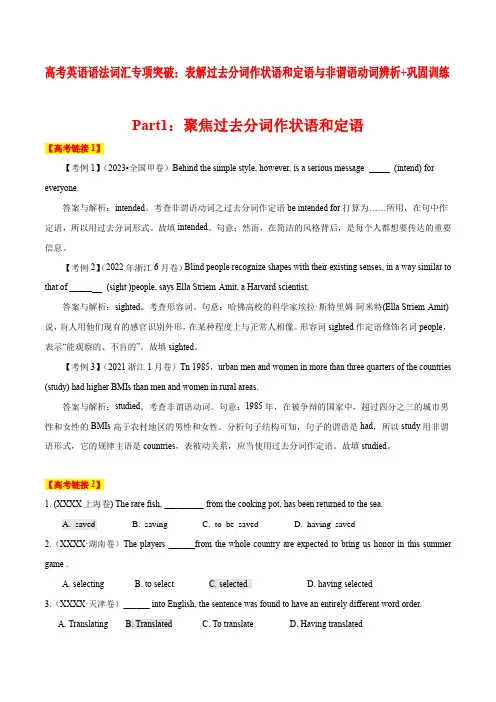
高考英语语法词汇专项突破:表解过去分词作状语和定语与非谓语动词辨析+巩固训练Part1:聚焦过去分词作状语和定语【高考链接1】everyone.答案与解析:intended。
考查非谓语动词之过去分词作定语be intended for打算为……所用,在句中作定语,所以用过去分词形式。
故填intended。
句意:然而,在简洁的风格背后,是每个人都想要传达的重要信息。
【考例2】(2022年浙江6月卷)Blind people recognize shapes with their existing senses, in a way similar to that of _____ (sight )people, says Ella Striem-Amit, a Harvard scientist.答案与解析:sighted。
考查形容词。
句意:哈佛高校的科学家埃拉·斯特里姆-阿米特(Ella Striem-Amit)说,盲人用他们现有的感官识别外形,在某种程度上与正常人相像。
形容词sighted作定语修饰名词people,表示“能观察的、不盲的”。
故填sighted。
【考例3】(2021浙江1月卷)Tn 1985,urban men and women in more than three quarters of the countries (study) had higher BMIs than men and women in rural areas.答案与解析:studied。
考查非谓语动词。
句意:1985年,在被争辩的国家中,超过四分之三的城市男性和女性的BMIs高于农村地区的男性和女性。
分析句子结构可知,句子的谓语是had,所以study用非谓语形式,它的规律主语是countries,表被动关系,应当使用过去分词作定语。
故填studied。
【高考链接2】1. (XXXX上海卷) The rare fish, _________ from the cooking pot, has been returned to the sea.A. savedB. savingC. to be savedD. having saved2.(XXXX·湖南卷)The players ______from the whole country are expected to bring us honor in this summer game .A. selectingB. to selectC. selectedD. having selected3.(XXXX·天津卷)______ into English, the sentence was found to have an entirely different word order.A. TranslatingB. TranslatedC. To translateD. Having translated4.( XXXX全国卷II 11)Though ______ to see us,the professor gave us a warm welcome。
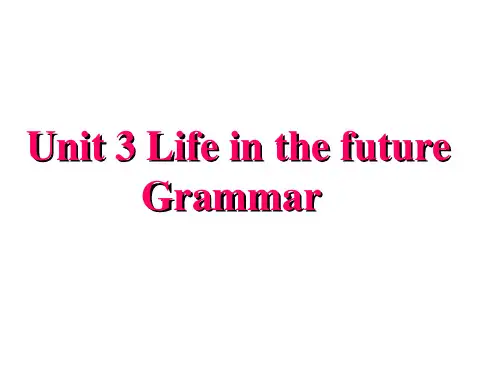
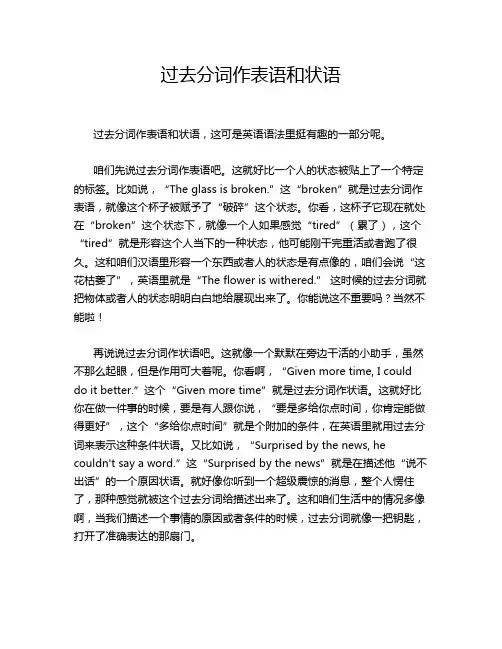
过去分词作表语和状语过去分词作表语和状语,这可是英语语法里挺有趣的一部分呢。
咱们先说过去分词作表语吧。
这就好比一个人的状态被贴上了一个特定的标签。
比如说,“The glass is broken.”这“broken”就是过去分词作表语,就像这个杯子被赋予了“破碎”这个状态。
你看,这杯子它现在就处在“broken”这个状态下,就像一个人如果感觉“tired”(累了),这个“tired”就是形容这个人当下的一种状态,他可能刚干完重活或者跑了很久。
这和咱们汉语里形容一个东西或者人的状态是有点像的,咱们会说“这花枯萎了”,英语里就是“The flower is withered.” 这时候的过去分词就把物体或者人的状态明明白白地给展现出来了。
你能说这不重要吗?当然不能啦!再说说过去分词作状语吧。
这就像一个默默在旁边干活的小助手,虽然不那么起眼,但是作用可大着呢。
你看啊,“Given more time, I could do it better.”这个“Given more time”就是过去分词作状语。
这就好比你在做一件事的时候,要是有人跟你说,“要是多给你点时间,你肯定能做得更好”,这个“多给你点时间”就是个附加的条件,在英语里就用过去分词来表示这种条件状语。
又比如说,“Surprised by the news, he couldn't say a word.”这“Surprised by the news”就是在描述他“说不出话”的一个原因状语。
就好像你听到一个超级震惊的消息,整个人愣住了,那种感觉就被这个过去分词给描述出来了。
这和咱们生活中的情况多像啊,当我们描述一个事情的原因或者条件的时候,过去分词就像一把钥匙,打开了准确表达的那扇门。
其实,过去分词作表语和状语在英语里无处不在。
你看那些英语文章、句子,就像一个充满各种小零件的大机器,过去分词作表语和状语就是其中很重要的小零件。
如果少了它们,这机器可能就运转得不太顺畅了。
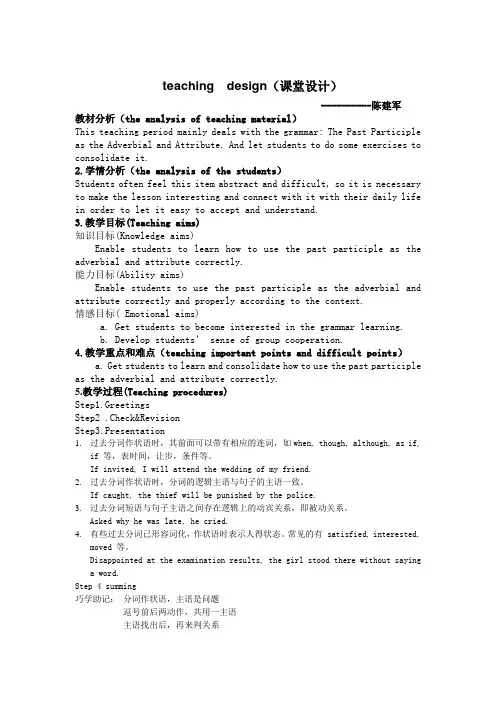
teaching design(课堂设计)----------陈建军教材分析(the analysis of teaching material)This teaching period mainly deals with the grammar: The Past Participle as the Adverbial and Attribute. And let students to do some exercises to consolidate it.2.学情分析(the analysis of the students)Students often feel this item abstract and difficult, so it is necessary to make the lesson interesting and connect with it with their daily life in order to let it easy to accept and understand.3.教学目标(Teaching aims)知识目标(Knowledge aims)Enable students to learn how to use the past participle as the adverbial and attribute correctly.能力目标(Ability aims)Enable students to use the past participle as the adverbial and attribute correctly and properly according to the context.情感目标( Emotional aims)a. Get students to become interested in the grammar learning.b. Develop students’ sense of group cooperation.4.教学重点和难点(teaching important points and difficult points)a. Get students to learn and consolidate how to use the past participle as the adverbial and attribute correctly.5.教学过程(Teaching procedures)Step1.GreetingsStep2 .Check&RevisionStep3.Presentation1.过去分词作状语时,其前面可以带有相应的连词,如when, though, although, as if,if 等,表时间,让步,条件等。
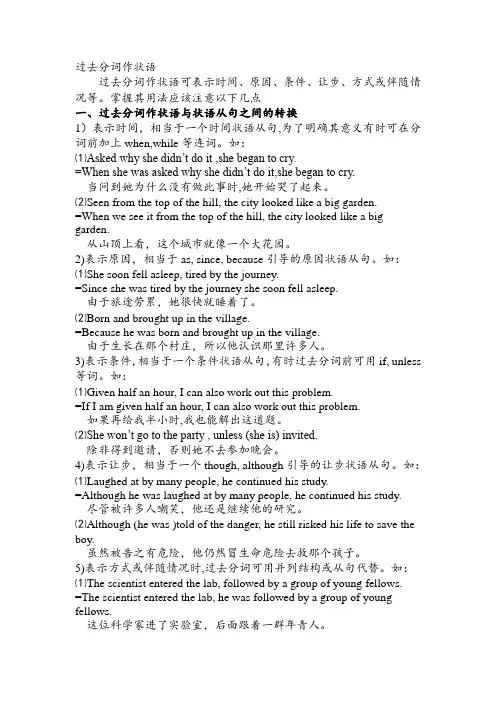
过去分词作状语过去分词作状语可表示时间、原因、条件、让步、方式或伴随情况等。
掌握其用法应该注意以下几点一、过去分词作状语与状语从句之间的转换1)表示时间,相当于一个时间状语从句,为了明确其意义有时可在分词前加上when,while等连词。
如:⑴Asked why she didn’t do it ,she began to cry.=When she was asked why she didn’t do it,she began to cry.当问到她为什么没有做此事时,她开始哭了起来。
⑵Seen from the top of the hill, the city looked like a big garden.=When we see it from the top of the hill, the city looked like a big garden.从山顶上看,这个城市就像一个大花园。
2)表示原因,相当于as, since, because引导的原因状语从句。
如:⑴She soon fell asleep, tired by the journey.=Since she was tired by the journey she soon fell asleep.由于旅途劳累,她很快就睡着了。
⑵Born and brought up in the village.=Because he was born and brought up in the village.由于生长在那个村庄,所以他认识那里许多人。
3)表示条件,相当于一个条件状语从句,有时过去分词前可用if, unless 等词。
如:⑴Given half an hour, I can also work out this problem.=If I am given half an hour, I can also work out this problem.如果再给我半小时,我也能解出这道题。
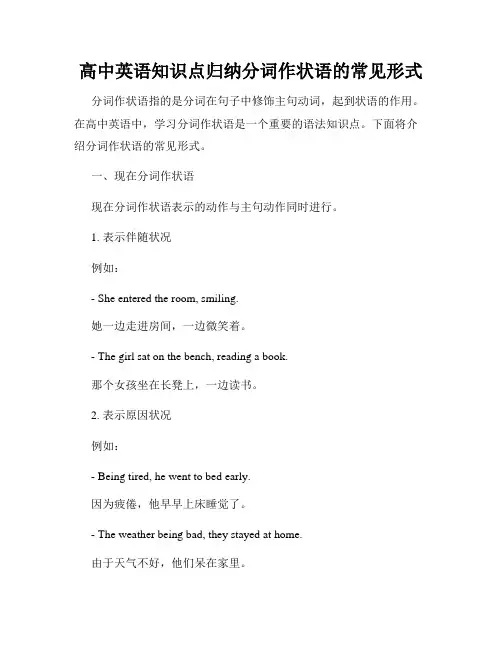
高中英语知识点归纳分词作状语的常见形式分词作状语指的是分词在句子中修饰主句动词,起到状语的作用。
在高中英语中,学习分词作状语是一个重要的语法知识点。
下面将介绍分词作状语的常见形式。
一、现在分词作状语现在分词作状语表示的动作与主句动作同时进行。
1. 表示伴随状况例如:- She entered the room, smiling.她一边走进房间,一边微笑着。
- The girl sat on the bench, reading a book.那个女孩坐在长凳上,一边读书。
2. 表示原因状况例如:- Being tired, he went to bed early.因为疲倦,他早早上床睡觉了。
- The weather being bad, they stayed at home.由于天气不好,他们呆在家里。
3. 表示条件状况例如:- I will go to the park, weather permitting.天气允许的话,我会去公园。
- We went out, the rain having stopped.雨停了,我们出去了。
4. 表示方式、手段状况例如:- He ran to the bus stop, hoping to catch the bus.他跑到公交车站,希望能赶上公交车。
- The boy solved the math problem, using the formula he had learned.这个男孩用他学过的公式解了这个数学问题。
二、过去分词作状语过去分词作状语表示的动作发生在主句动作之前。
1. 表示时间状况例如:- Having finished his homework, he went out to play.他完成了作业后,出去玩了。
- We arrived at the airport, having missed the flight.我们到达机场时,航班已经错过了。
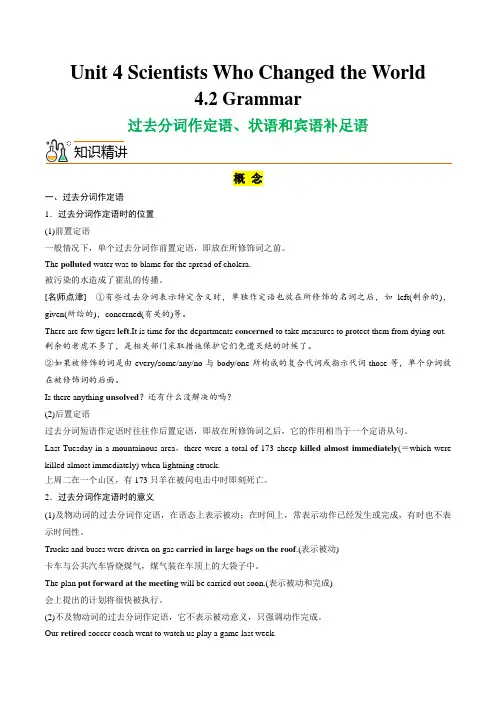
Unit 4 Scientists Who Changed the World4.2 Grammar过去分词作定语、状语和宾语补足语知识精讲概念一、过去分词作定语1.过去分词作定语时的位置(1)前置定语一般情况下,单个过去分词作前置定语,即放在所修饰词之前。
The polluted water was to blame for the spread of cholera.被污染的水造成了霍乱的传播。
[名师点津]①有些过去分词表示特定含义时,单独作定语也放在所修饰的名词之后,如left(剩余的),given(所给的),concerned(有关的)等。
There are few tigers left.It is time for the departments concerned to take measures to protect them from dying out. 剩余的老虎不多了,是相关部门采取措施保护它们免遭灭绝的时候了。
②如果被修饰的词是由every/some/any/no与body/one所构成的复合代词或指示代词those等,单个分词放在被修饰词的后面。
Is there anything unsolved?还有什么没解决的吗?(2)后置定语过去分词短语作定语时往往作后置定语,即放在所修饰词之后,它的作用相当于一个定语从句。
Last Tuesday in a mountainous area,there were a total of 173 sheep killed almost immediately(=which were killed almost immediately) when lightning struck.上周二在一个山区,有173只羊在被闪电击中时即刻死亡。
2.过去分词作定语时的意义(1)及物动词的过去分词作定语,在语态上表示被动;在时间上,常表示动作已经发生或完成,有时也不表示时间性。
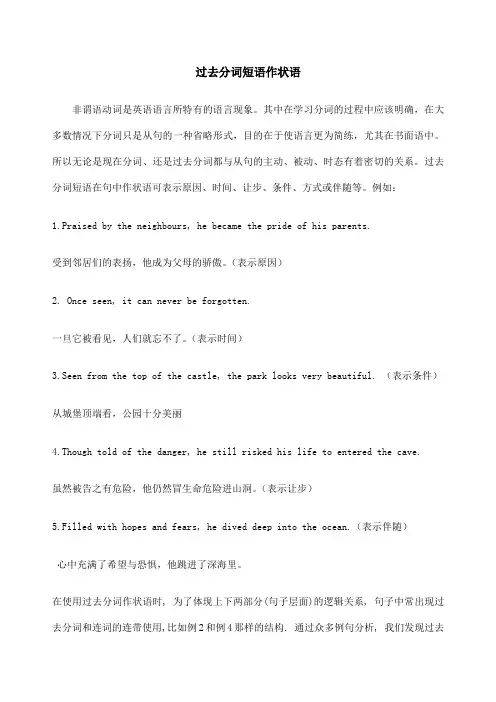
过去分词短语作状语非谓语动词是英语语言所特有的语言现象。
其中在学习分词的过程中应该明确,在大多数情况下分词只是从句的一种省略形式,目的在于使语言更为简练,尤其在书面语中。
所以无论是现在分词、还是过去分词都与从句的主动、被动、时态有着密切的关系。
过去分词短语在句中作状语可表示原因、时间、让步、条件、方式或伴随等。
例如:1.Praised by the neighbours, he became the pride of his parents.受到邻居们的表扬,他成为父母的骄傲。
(表示原因)2. Once seen, it can never be forgotten.一旦它被看见,人们就忘不了。
(表示时间)3.Seen from the top of the castle, the park looks very beautiful. (表示条件)从城堡顶端看,公园十分美丽4.Though told of the danger, he still risked his life to entered the cave.虽然被告之有危险,他仍然冒生命危险进山洞。
(表示让步)5.Filled with hopes and fears, he dived deep into the ocean.(表示伴随)心中充满了希望与恐惧,他跳进了深海里。
在使用过去分词作状语时, 为了体现上下两部分(句子层面)的逻辑关系, 句子中常出现过去分词和连词的连带使用,比如例2和例4那样的结构. 通过众多例句分析, 我们发现过去分词作状语以下几种情形:一、句子的主语与作状语用的过去分词之间在逻辑上是被动的关系例:_______ by the beauty of nature, the girl from London decided to spend another two days on the farm .(2004,辽宁)A.Attracting B.Attracted C. To be attracted D.Having attracted 分析:答案为B。
Section ⅢGrammar——过去分词作表语和状语一、过去分词作表语1.意义位于系动词(如be,get,become,look,feel,seem等)之后,多表示主语的状态或状况,它所体现的是形容词的特性。
She looked disappointed.她看上去很失望。
We were encouraged at the news.听到这个消息我们很受鼓舞。
2.过去分词作表语与被动语态的区别过去分词作表语时,强调主语所处的状态,而动词的被动语态表示主语是动作的承受者,强调动作。
The cup is broken.杯子破了。
(系表结构)The cup was broken by Tom.杯子是被汤姆打破的。
(被动语态)3.现在分词与过去分词作表语的区别他们变得如此担心,以致一整晚都没有睡觉。
The situation became so worrying that something should be done at once.形势变得令人担忧,应该立刻采取措施。
[即时训练1]单句语法填空①I was too tired (tire) to walk any further.②When he heard the moving story,he was deeply moved.(move)③Tom was more surprised (surprise) than disappointed(disappoint) at this news.二、过去分词作状语1.过去分词作状语,表示被动或完成的动作可以表示时间、原因、条件、让步、方式或伴随情况等。
(1)作时间状语过去分词作时间状语时,相当于一个when,while,after,once等引导的时间状语从句。
Once published(=Once it is published),the dictionary will be very popular.一旦出版,这本词典将大受欢迎。
过去分词短语作状语非谓语动词是英语语言所特有的语言现象。
其中在学习分词的过程中应该明确,在大多数情况下分词只是从句的一种省略形式,目的在于使语言更为简练,尤其在书面语中。
所以无论是现在分词、还是过去分词都与从句的主动、被动、时态有着密切的关系。
过去分词短语在句中作状语可表示原因、时间、让步、条件、方式或伴随等。
例如:1.Praised by the neighbours, he became the pride of his parents.受到邻居们的表扬,他成为父母的骄傲。
(表示原因)2. Once seen, it can never be forgotten.一旦它被看见,人们就忘不了。
(表示时间)3.Seen from the top of the castle, the park looks very beautiful. (表示条件)从城堡顶端看,公园十分美丽4.Though told of the danger, he still risked his life to entered the cave.虽然被告之有危险,他仍然冒生命危险进山洞。
(表示让步)5.Filled with hopes and fears, he dived deep into the ocean.(表示伴随)心中充满了希望与恐惧,他跳进了深海里。
在使用过去分词作状语时, 为了体现上下两部分(句子层面)的逻辑关系, 句子中常出现过去分词和连词的连带使用,比如例2和例4那样的结构. 通过众多例句分析, 我们发现过去分词作状语以下几种情形:一、句子的主语与作状语用的过去分词之间在逻辑上是被动的关系例:_______ by the beauty of nature, the girl from London decided to spend another two days on the farm .(2004,辽宁)A.Attracting B.Attracted C. To be attracted D.Having attracted分析:答案为B。
Section ⅢGrammar——过去分词(短语)作状语[语境自主领悟]过去分词作状语,修饰谓语动词,进一步说明谓语动词的动作和状态,即动作发生时的背景或状况,其逻辑主语通常就是句子的主语,且过去分词与主语之间为动宾关系。
考点一过去分词(短语)作状语的句法功能和位置1.过去分词(短语)表示被动,表示动作已经完成,其逻辑主语则为句子的主语。
过去分词作状语时,可单独使用,也可以在其前面加上适当的连词,可表示时间、条件、原因、让步、方式、伴随等。
When offered help,one often says“Thank you”or“It's kind of you”.(时间状语)当被提供帮助的时候,人们常说“Thank you”或“It's kind of you”。
Given another chance,I will do it much better.(条件状语)如果再给我一次机会,我会干得更好。
Greatly inspired by what he did,I joined him in helping others.(原因状语)在他所做的事情的鼓励下,我也加入了帮助他人的行列。
Visited many times,the place is still worth visiting again.(让步状语)虽然已参观了很多次,这个地方仍值得再来。
He has been preparing his paper all day long,locked in his study.(方式状语) 锁在书房里,他一整天都在准备论文。
The guest walked into the room,greeted by his owner.(伴随状语)客人一边和主人打招呼,一边走进了房间。
2.过去分词(短语)在句中作状语时,既可放在句首,也可放在句尾,中间用逗号隔开。
Caught in a heavy rain,he was all wet.因为淋了一场大雨,所以他全身湿透了。
单个过去分词作状语过去分词是一种语法形式,通常由动词加上-ed构成,也有一些不规则的形式,比如go-gone、eat-eaten 等。
过去分词在英语语法中可以用于多种表达方式,其中包括作状语。
在英语语法中,单个过去分词可以作为状语,修饰句子的谓语动词,表示一种时间关系、结果、条件、原因等。
在这篇文章中,我们将详细探讨单个过去分词作状语的用法和注意事项。
一、时间状语单个过去分词作为时间状语,常常表示动作发生的时间,常常用于过去完成时,表明一个过去的动作发生在另一个过去的动作之前。
例如:Having finished his homework, he went to bed.完成了作业后,他就去睡觉了。
Having got up early, he went for a morning run.早起后,他去晨跑了。
类似地,过去分词也可以作为状语来表达一个具体时间或时间段的情况。
例如:Having lived in London for five years, he knows the city well.他在伦敦住了五年,所以对这个城市非常了解。
Having studied English for many years, he can speak it fluently.由于学了很多年英语,他能够流利地讲英语。
二、结果状语单个过去分词还可以用作表示结果的状语。
这种用法常常使用在表示因果关系的句子中,例如:The thief ran away, leaving the stolen goods behind.小偷逃跑了,把赃物留在了身后。
They worked hard all day, finishing the project on time.他们一整天都在努力工作,终于按时完成了项目。
三、条件状语过去分词还可以用作表示条件的状语。
这些用法经常使用在表示条件的句子中,例如:If the weather permits, we’ll have a picnic in the park.如果天气允许,我们会在公园里野餐。